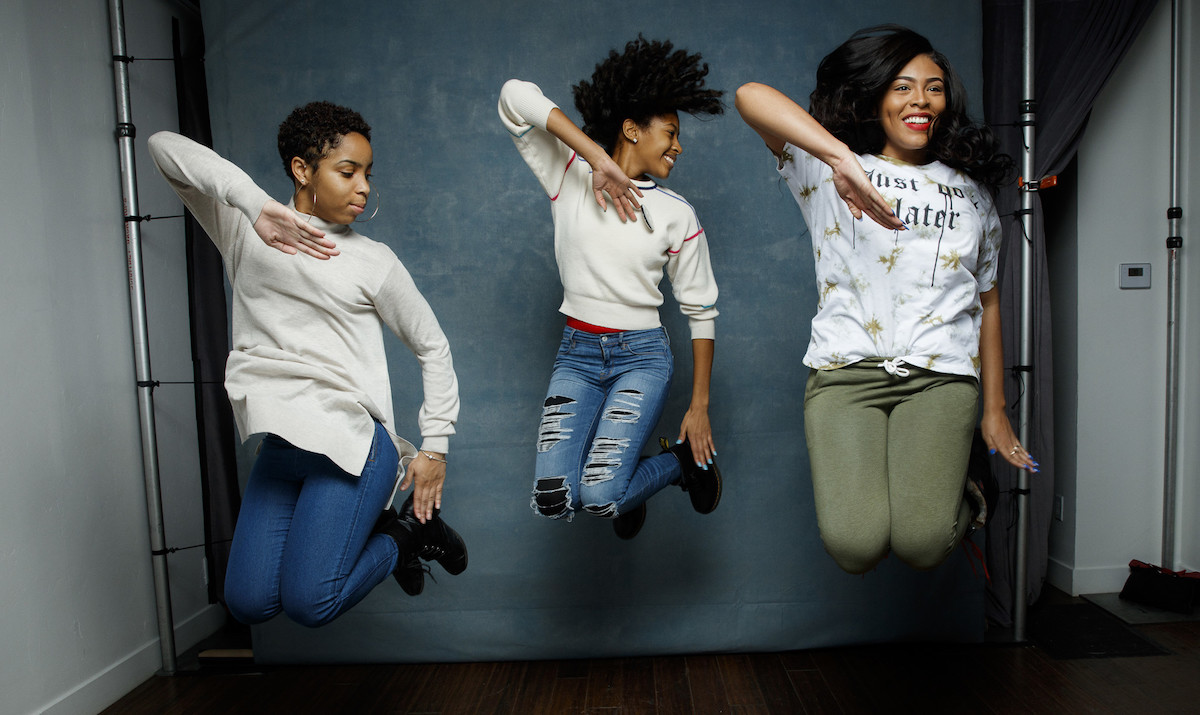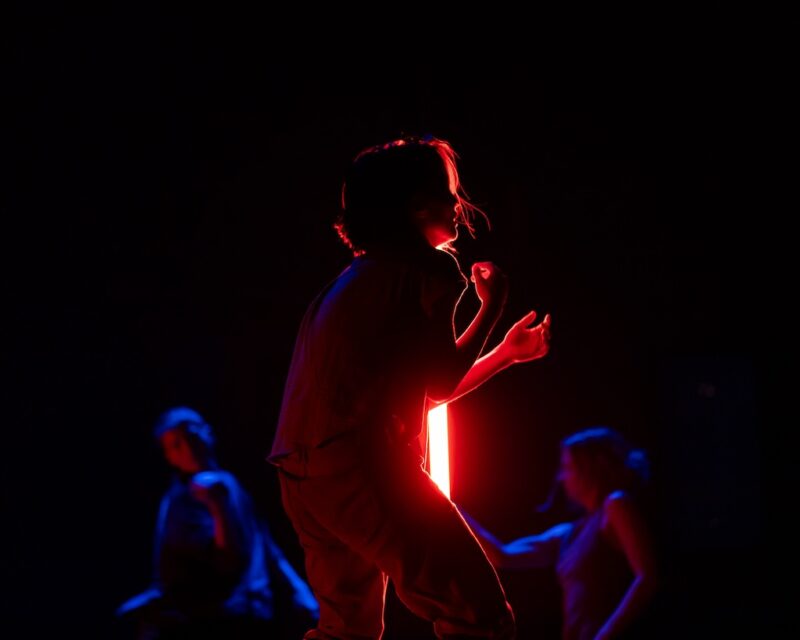A Conversation with Sundance Sensation STEP’s Director Amanda Lipitz by Christopher Llewellyn Reed
I spoke with director Amanda Lipitz on Monday, July 24, at the Four Seasons Hotel in downtown Baltimore, about her feature documentary debut, STEP, a powerful new documentary set in the Baltimore Leadership School for Young Women, a charter school in the city. Lipitz profiles three young women and their families as they navigate their senior year, which just happens to be the first year that the school is graduating a senior class.
We follow Blessin, Cori, and Tayla, along with their step coach, Gari McIntyre, and their extremely committed guidance counselor, Paula Dofat, who together help their charges emerge from their secondary-school years with promising prospects ahead. Through step competitions and college applications, we watch them grow into the bold young women they were always meant to be. What follows is a condensed version of our conversation, edited for clarity.
 STEP (Amanda Lipitz, 2017)
STEP (Amanda Lipitz, 2017)
This is your feature-documentary directorial debut …
Correct!
… though you have made many short documentaries before this and have a background as a Broadway producer. How did you come by this subject, and when did you decide to make a feature out of it, with you in the director’s chair?
So, I’m a Broadway producer, and on the side I’ve been directing shorts about first-generation students going to college, and girls’ education, and I fell in love with a group of schools in New York, called the Young Women’s Leadership Schools. I was working with them, and they had a 100% graduation rate, and I was blown away by their model, that special sauce they had of churning out these incredible young women. And I am born and raised in Baltimore, and my mom is born and raised in Baltimore and has been an activist here my whole life, and I suggested to her that she might want to replicate one of these schools in Baltimore … and she did. And she recruited her daughter to make short films for her.
Did you grow up in the city, itself?
I grew up in Owings Mills.
 Director Amanda Lipitz
Director Amanda Lipitz
And your mother founded the school that is profiled in the movie?
Yes.
And I know this information is in the movie, but remind me when the school was founded …
It started in 2009, with 120 6th graders that were selected by lottery. So, I met these young women when they were 11 years old, and they just watched me kind of coming in and out of their school, 5 to 6 times a year, with cameras. Step was not something that I was familiar with, but I had heard that the 6th graders had started a step team. It wasn’t part of my culture, growing up. I didn’t know about the rich history of it coming from the mines in Africa and then becoming a collegiate sport in North America. And in the 8th grade, Blessin asked me if, the next time I came to school with cameras, I would come film the step team. And I walked in, and they were stepping, and for me it was like something that happens in a great musical, when a character expresses their feelings through music, rather than through speech.
So you spent quite a lot of time watching these women grow up. Did you ever consider doing a sort of Steve James’ Hoop Dreams kind of movie? Because you really just focus on the final year of their school experience, here.
So, Hoop Dreams is a huge inspiration for me, and one of my favorites, and I got to meet Steve a few months ago, and that was really an amazing moment. But I wanted to focus on senior year, even though I started filming them for the documentary in the 10th grade, because I knew – from all the time I had filmed my shorts – that the senior year is just this incredible roller-coaster ride of high stakes. And that was also very much a musical trope: you want to have a very clear beginning, middle and end.
 The Lethal Ladies step team, Photo courtesy of Fox Searchlight Pictures
The Lethal Ladies step team, Photo courtesy of Fox Searchlight Pictures
Sure. And the competition within the film helps with the narrative, as well. And they’re applications to college help, too. Dramatically, that makes a lot of sense. Is there footage, however, from earlier years, woven into what appears to be just about the senior year?
No. There is no footage from any other year but senior year. There are a couple soundbites, in some interviews, in the beginning, that are from 10th grade, when I first sat down and asked them what step meant to them.
Did the fact that your mother was the founder of the school simplify the usual documentary-movie issues of access?
It actually made it more complicated.
Explain.
Well, first of all, I was on the school’s board at the time, so I resigned from the board, because I couldn’t be a part of the vote to allow me to film. So they voted on it, and we had very clear boundaries around what kind of filming could be allowed in the school for the documentary. Above all else, I cared about the school and the girls. The documentary came second to that at all times, and still does, to this day. What is best for the girls is the most important thing. We certainly didn’t want to make the other 500 girls in the school think that you needed to have cameras following you every day to be special, so our time spent filming in classrooms was extremely limited. In fact, the only time we really filmed Blessin in a classroom is when you see her making her presentation.
We had very detailed production calendars showing where we were going to be filming and when. There were very strict rules around it, and we followed them to a T. And the fact that my mother was involved in the founding of the school made it so that I had to cross my T’s and dot my I’s. I didn’t want anyone to be able to say, “Well, you got this access because of your mom.” I worked many years and had many meetings with these families, off camera, creating relationships. And really, the reason we all wanted to make this film was to change the conversation about Baltimore.
Along those lines, I love the fact that the film is about more than just step. Step is merely the vehicle through which we get to know your characters’ stories. Were there other potential such vehicles at the school, beyond step – other activities – that you discarded in favor of step, as your way in?
Well, I did a short with the track team, called On the Right Track, that you can see online. They were amazing. But step was the first elective that the school ever had. So it was the very first extracurricular activity. And for a while, the only one, because when they started, they were in a corner of Western High School, and they were there for a few years before they renovated and moved into their building on Franklin Street. So it was the only thing to do for a very long time. It wasn’t like I was considering making a documentary about other extracurricular activities, because there weren’t any.
Got it.
I also think step is this unbelievably unique thing, because it’s not dance, and yet it’s this very expressive art form that uses words, and your whole body is an instrument. At the same time, it needs to be done as a team and as a competitive sport. I don’t really know anything else that is like that.
It’s a hybrid between art and sport: competitive art!
Yes! Competitive art! But it’s also psychological art, too, because there’s this deep psychology about being in sync, and the sisterhood and the team work. There’s just this whole other level to it.
Beyond what you’ve just articulated about the challenges of filming at the school, what about when you filmed at the competition at Bowie State, where you were filming even more underage high school students from different institutions? Any problems there, getting permission?
No. We just worked really hard. I had a great team of people. And when we filmed the Baltimore City Step Show, we went to every single school, and we shot every single school’s rehearsal, and sat down and talked to every single girl and coach about what step meant to them. They were all pretty much game. Everybody thought documentaries were cool. There were some issues, at times, with location agreements and things like that, but other than that, nothing.
Was there any resistance on the part of some of your primary subjects to letting you into their lives as intimately as you go?
A little bit, but not a ton, because we knew each other so well, and we all had this higher purpose we were trying to serve by telling the truth and changing the conversation about Baltimore and inspiring other young people to live out their dreams. The challenges were, in dealing with 19 teenage girls, making everyone feel that they mattered, and making sure that their voices were heard, and that we were all making this movie together. Just because Blessin, Cori and Tayla are the ones we primarily track through, we worked really hard – Penelope Falk, my editor, and I – to make you feel that this is a film about a team. It’s not just about three girls.
 Author Christopher Reed and Amanda Lipitz
Author Christopher Reed and Amanda Lipitz
Did you winnow it down from a larger cast of characters and then end up with those three?
Yes. I had a few other stories, and then yes, we whittled it down in the editing room.
Three is a good number. And those three are particularly compelling, in different ways.
And there were two arcs: the arc of senior year and the arc of the step team. That was the through line, and then the three stories fell within that.
Speaking of the editing, what was your shooting-to-finished-film ratio?
We shot 400 hours, and the film is 83 minutes.
Wow. Quite an accomplishment!
Yeah! (laughs)
You open the film in middle of the city’s reaction to the Freddie Gray killing, and so your entire movie takes place in that context. You have mentioned, a few times, wanting to change the conversation about Baltimore. What are your hopes for how STEP might do that?
Well, I don’t feel like I’m an expert on the temperature of Baltimore City. There are lots of people that are, and I hope this film brings that conversation to the forefront. I hope that people in Detroit, in Philadelphia, in Chicago, in Anywhere, USA – cities in America with similar problems – see this film and it encourages them to go look at the pockets of joy and hope in their city, and the way communities are coming together in their city. Because this school – Baltimore Leadership School for Young Women – is successful because of Baltimore, because Baltimore has made it successful. And the people who are in it are of Baltimore. But I think that this is happening everywhere, and we just have to look for it. It’s not that hard to find.
Well, congrats on the film! I enjoyed it very much!
Thank you!
Fox Searchlight will begin to release STEP on August 4. It is currently slated to open at the Charles Theatre, in Baltimore, on August 11.
Featured image courtesy of Fox Searchlight Pictures.






